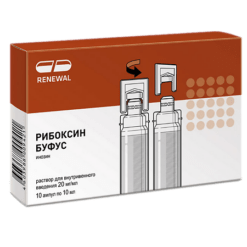No products in the cart.
Riboxin Bufus, 20 mg/ml 5 ml 10 pcs
€7.04 €6.16
Description
Riboxin is a derivative (nucleoside) of purine – a precursor of adenosine triphosphate (ATP). It belongs to the group of drugs that stimulate metabolic processes. It has antihypoxic and antiarrhythmic effects. It increases myocardial energy balance, improves coronary circulation, and prevents the consequences of intraoperative renal ischemia. It is directly involved in glucose metabolism and promotes the activation of metabolism in hypoxia and in the absence of ATP.
Activates the metabolism of pyruvic acid, which is necessary for the normal process of tissue respiration, and also promotes the activation of xanthine dehydrogenase. It stimulates the synthesis of nucleotides and enhances the activity of some Krebs cycle enzymes.
Infiltrating the cells has a positive effect on metabolic processes in the myocardium – it increases the force of heart contractions and promotes fuller myocardial relaxation in diastole, resulting in an increase of stroke volume. The mechanism of antiarrhythmic action is not fully understood.
Limits platelet aggregation, activates tissue regeneration (especially myocardium and gastrointestinal mucosa).
Pharmacokinetics
Metabolized in the liver with the formation of glucuronic acid and its subsequent oxidation. A small amount is excreted in the urine.
Indications
Indications
Complex treatment of myocardial infarction, ischemic heart disease, cardiac rhythm disturbances caused by the use of cardiac glycosides, against myocardiodystrophy after infectious diseases.
Liver diseases (hepatitis, cirrhosis, fatty dystrophy), urocoproporphyria.
The operations on the isolated kidney (as a means of pharmacological protection when the circulation is switched off).
Active ingredient
Active ingredient
Composition
Composition
1 ml of the solution contains:
active ingredient:
Inosine (riboxin) – 20 mg
excipients:
methenamine (hexamethylentetramine) – 2 mg
sodium hydroxide
(1 M sodium hydroxide solution) – to pH 7.8-8.6
water for injection – up to 1 ml
How to take, the dosage
How to take, the dosage
The drug is administered intravenously by slow trickle or drip (40-60 drops per 1 minute). Treatment starts with administration of 200 mg (10 ml of 2% solution) once a day, then, if tolerated well, the dose is increased to 400 mg (20 ml of 2% solution) 1-2 times a day. The duration of treatment is 10-15 days.
Jettison administration of the drug is possible in acute cardiac arrhythmias in a single dose of 200-400 mg (10-20 ml of 2% solution).
For pharmacologic protection of the renal artery subjected to ischemia, riboxin is administered intravenously by injection in a single dose of 1200 mg (60 ml 2% solution) 5-15 minutes before renal artery clamping and then another 800 mg (40 ml 2% solution) immediately after restoration of blood flow.
In case of drop instillation into a vein the 2% solution of the drug is diluted in 5% dextrose (glucose) solution or isotonic sodium chloride solution (up to 250 ml).
Contraindications
Contraindications
Side effects
Side effects
Allergic reactions: skin itching, skin hyperemia, urticaria (the drug should be discontinued).
Rarely: increase of uric acid concentration in the blood, exacerbation of gout (with long-term use).
Similarities
Similarities
Additional information
| Shelf life | 3 years |
|---|---|
| Conditions of storage | In a light-protected place at 15-25 °C. |
| Manufacturer | Update PFC AO, Russia |
| Medication form | solution |
| Brand | Update PFC AO |
Other forms…
Related products
Buy Riboxin Bufus, 20 mg/ml 5 ml 10 pcs with delivery to USA, UK, Europe and over 120 other countries.













